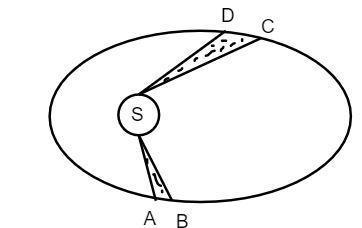
The motion of a planet around the sun in an elliptical orbit is shown in the following figure. Sun is situated in one focus. The shaded areas are equal. If the planet takes time ${t_1}$ and ${t_2}$ in moving from $A$ to $B$ and from $C$ to $D$ respectively then
(A) ${t_1} > {t_2}$
(B) ${t_1} < {t_2}$
(C) ${t_1} = {t_2}$
(D) information incomplete
Answer
218.7k+ views
Hint: Kepler’s law is applicable for the motion of the planet which moves around the centre of gravity, sun. use this law to solve this problem. Rearranging the Kepler’s law and substituting both the areas are the same provides the relation between the time taken.
Useful formula:
The formula of the Kepler’s law of planetary motion is given by
$\dfrac{{dA}}{{dt}} = {\text{constant}}$
${t_1} = {t_2}$Where $dA$ is the change in the area and $dt$ is the change in the time taken to cover the area.
Complete step by step solution:
It is given that the Sun is the centre of the focus for the Earth to rotate in the elliptical path. From the given diagram and the given data, the shaded areas of $AB$ and $CD$ are the same. The time taken to cover the area of $AB$ is ${t_1}$ and the time taken to cover the area of $CD$ is ${t_2}$ .
Let us consider Kepler's law of the area of planetary motion. This law states that the line joining the sun and the planet will cover an equal area in the certain interval of time. This can also be said as the area velocity is constant.
$
\dfrac{{dA}}{{dt}} = {\text{constant}} \\
\dfrac{{{A_1}}}{{{t_1}}} = \dfrac{{{A_2}}}{{{t_2}}} \\
{t_1} = \dfrac{{{A_1}}}{{{A_2}}}{t_2} \\
$
Since the areas covered by both the lines are same, then ${A_1} = {A_2}$
${t_1} = {t_2}$
Hence the time taken will also be equal for both the areas.
Thus the option (C) is correct.
Note: Let us see the derivation of the Kepler’s law used in the above solution. It is known that the $L = \dfrac{{mA}}{t}$ , bringing $m$ to left hand side of the equation, we get, $\dfrac{L}{m} = \dfrac{A}{t}$ . Since the sun is the centre of gravity, the angular momentum is constant. The mass is also constant. So the $LHS$ is also constant. Hence $\dfrac{A}{t} = {\text{constant}}$ .
Useful formula:
The formula of the Kepler’s law of planetary motion is given by
$\dfrac{{dA}}{{dt}} = {\text{constant}}$
${t_1} = {t_2}$Where $dA$ is the change in the area and $dt$ is the change in the time taken to cover the area.
Complete step by step solution:
It is given that the Sun is the centre of the focus for the Earth to rotate in the elliptical path. From the given diagram and the given data, the shaded areas of $AB$ and $CD$ are the same. The time taken to cover the area of $AB$ is ${t_1}$ and the time taken to cover the area of $CD$ is ${t_2}$ .
Let us consider Kepler's law of the area of planetary motion. This law states that the line joining the sun and the planet will cover an equal area in the certain interval of time. This can also be said as the area velocity is constant.
$
\dfrac{{dA}}{{dt}} = {\text{constant}} \\
\dfrac{{{A_1}}}{{{t_1}}} = \dfrac{{{A_2}}}{{{t_2}}} \\
{t_1} = \dfrac{{{A_1}}}{{{A_2}}}{t_2} \\
$
Since the areas covered by both the lines are same, then ${A_1} = {A_2}$
${t_1} = {t_2}$
Hence the time taken will also be equal for both the areas.
Thus the option (C) is correct.
Note: Let us see the derivation of the Kepler’s law used in the above solution. It is known that the $L = \dfrac{{mA}}{t}$ , bringing $m$ to left hand side of the equation, we get, $\dfrac{L}{m} = \dfrac{A}{t}$ . Since the sun is the centre of gravity, the angular momentum is constant. The mass is also constant. So the $LHS$ is also constant. Hence $\dfrac{A}{t} = {\text{constant}}$ .
Recently Updated Pages
Two discs which are rotating about their respective class 11 physics JEE_Main

A ladder rests against a frictionless vertical wall class 11 physics JEE_Main

Two simple pendulums of lengths 1 m and 16 m respectively class 11 physics JEE_Main

The slopes of isothermal and adiabatic curves are related class 11 physics JEE_Main

A trolly falling freely on an inclined plane as shown class 11 physics JEE_Main

The masses M1 and M2M2 M1 are released from rest Using class 11 physics JEE_Main

Trending doubts
JEE Main 2026: Application Form Open, Exam Dates, Syllabus, Eligibility & Question Papers

Derivation of Equation of Trajectory Explained for Students

Hybridisation in Chemistry – Concept, Types & Applications

Understanding the Angle of Deviation in a Prism

Understanding Collisions: Types and Examples for Students

Understanding Atomic Structure for Beginners

Other Pages
JEE Advanced Marks vs Ranks 2025: Understanding Category-wise Qualifying Marks and Previous Year Cut-offs

Units And Measurements Class 11 Physics Chapter 1 CBSE Notes - 2025-26

NCERT Solutions For Class 11 Physics Chapter 8 Mechanical Properties Of Solids

Motion in a Straight Line Class 11 Physics Chapter 2 CBSE Notes - 2025-26

NCERT Solutions for Class 11 Physics Chapter 7 Gravitation 2025-26

How to Convert a Galvanometer into an Ammeter or Voltmeter




